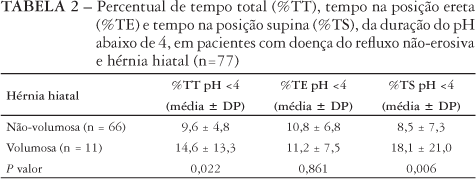BACKGROUND: In the last few years studies have demonstrated that hiatal hernias have an important role in the pathogenesis of reflux disease, promoting reflux by many different mechanisms, emphasizing that the larger the hiatal hernia, the higher the reflux intensity and erosive esophagitis prevalence. AIM: To correlate the size of hiatal hernias (small or large) with reflux intensity (measured by pH monitoring parameters) in patients with non-erosive and erosive reflux disease. PATIENTS AND METHODS: We reviewed pH monitoring from patients with typical reflux symptoms (heartburn) previously submitted to upper endoscopy. Reflux intensity was measured by the % of total time of pH <4 (%TT) and by % of time of pH <4 in upright (%UT) and supine (%ST) positions. Patients were classified as non-erosive reflux disease if no erosive esophagitis was found in endoscopy and pH monitoring was abnormal and as erosive reflux disease if they had erosive esophagitis. Hiatal hernias were classified as small if their size ranged from 2 to 4 cm and large if >5 cm. RESULTS: A total of 192 patients were included, being 115 in erosive reflux disease group and 77 in non-erosive reflux disease group. In erosive reflux disease patients, there were 94 (81%) with small hiatal hernias and 21 (19%) with large ones and in non-erosive reflux disease patients there were 66 (85%) with small and 11(15%) with large hiatal hernias. In erosive reflux disease group, the %TT, %UT and %ST were of 13.1 + 7.1; 13.4 + 7.4 and 12.3 + 11.5 in small hiatal hernias and 20.2 + 12.3; 17.8 + 14.1 and 20.7 + 14.1 in large hiatal hernias, respectively (P <0,05 for %TT and %TS). In non-erosive reflux disease patients, %TT, %UT and %ST were 9.6 + 4.8; 10.8 + 6.8 and 8.6 + 7.3 in small hiatal hernias and of 14.6 + 13.3; 11.2 + 7.5 and 18.1 + 21.0 in large hiatal hernias respectively (P <0,05 for %TT and %TS). CONCLUSION: Large hiatal hernias increase acid exposure time only in supine position in erosive esophagitis patients and in non-erosive patients.
Hernia, hiatal; Gastroesophageal reflux; Esophagitis, peptic; Manometry


